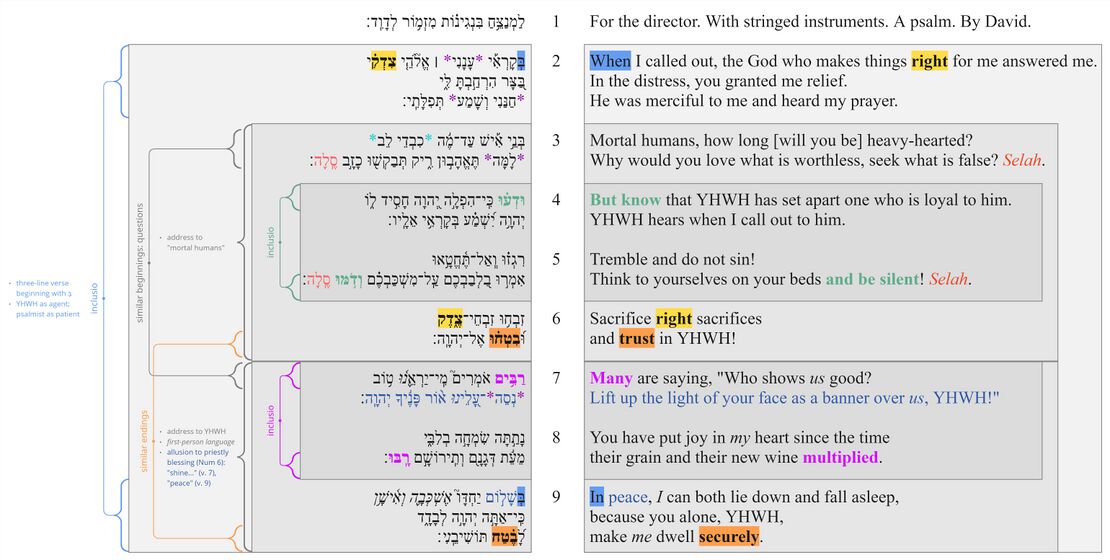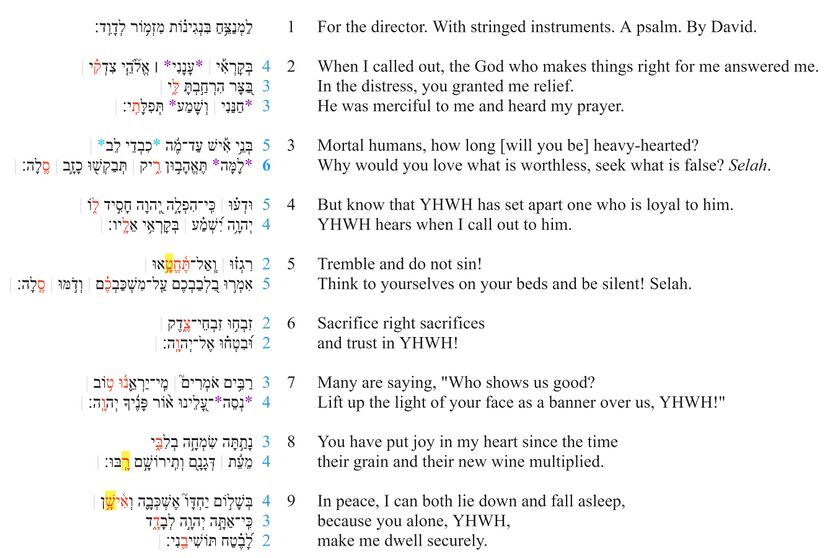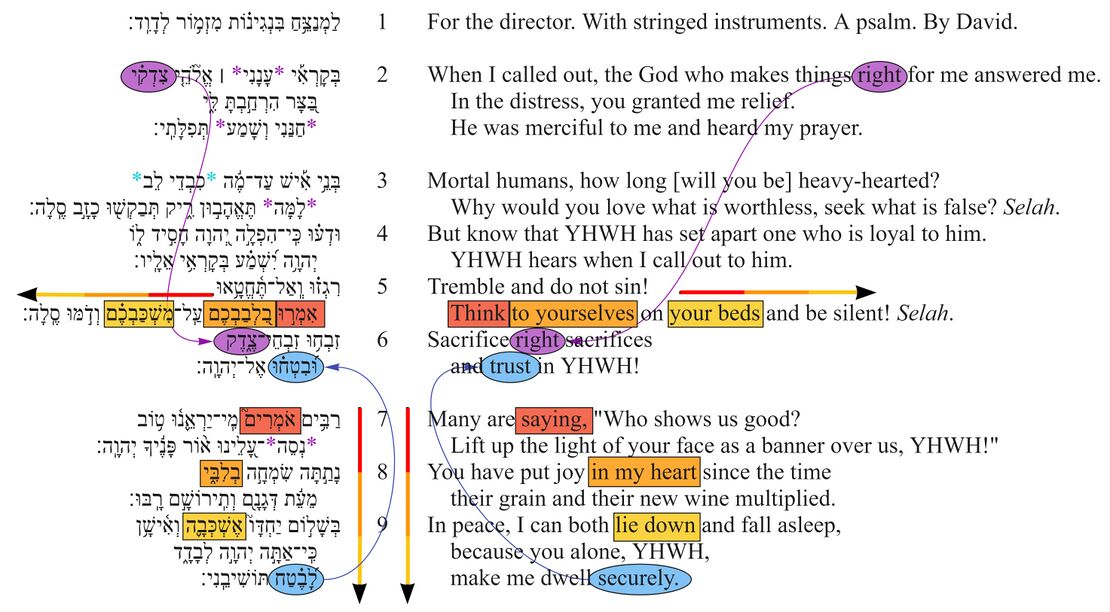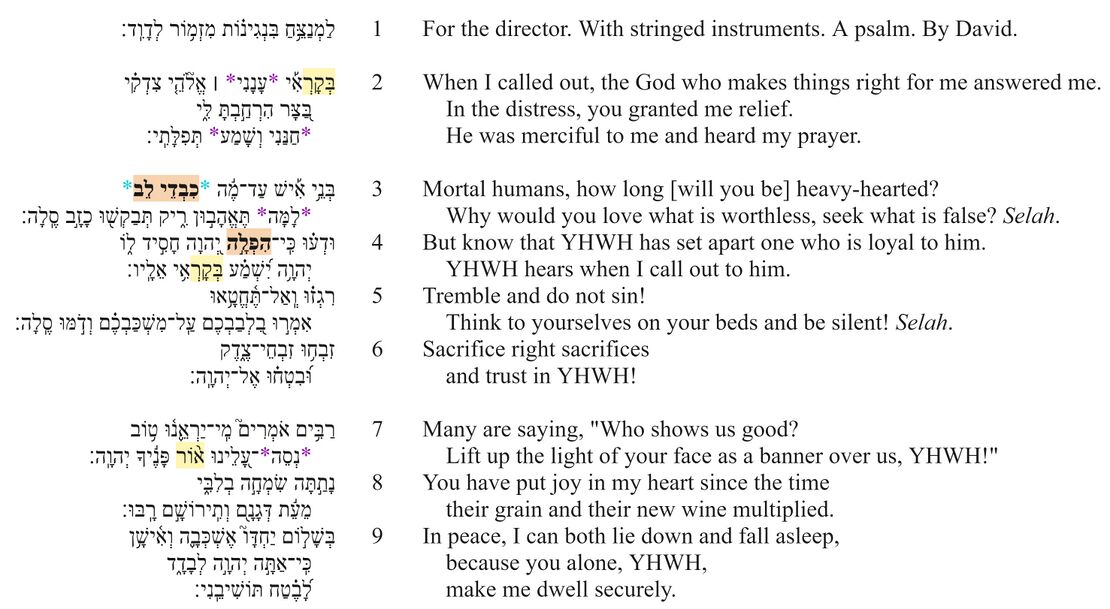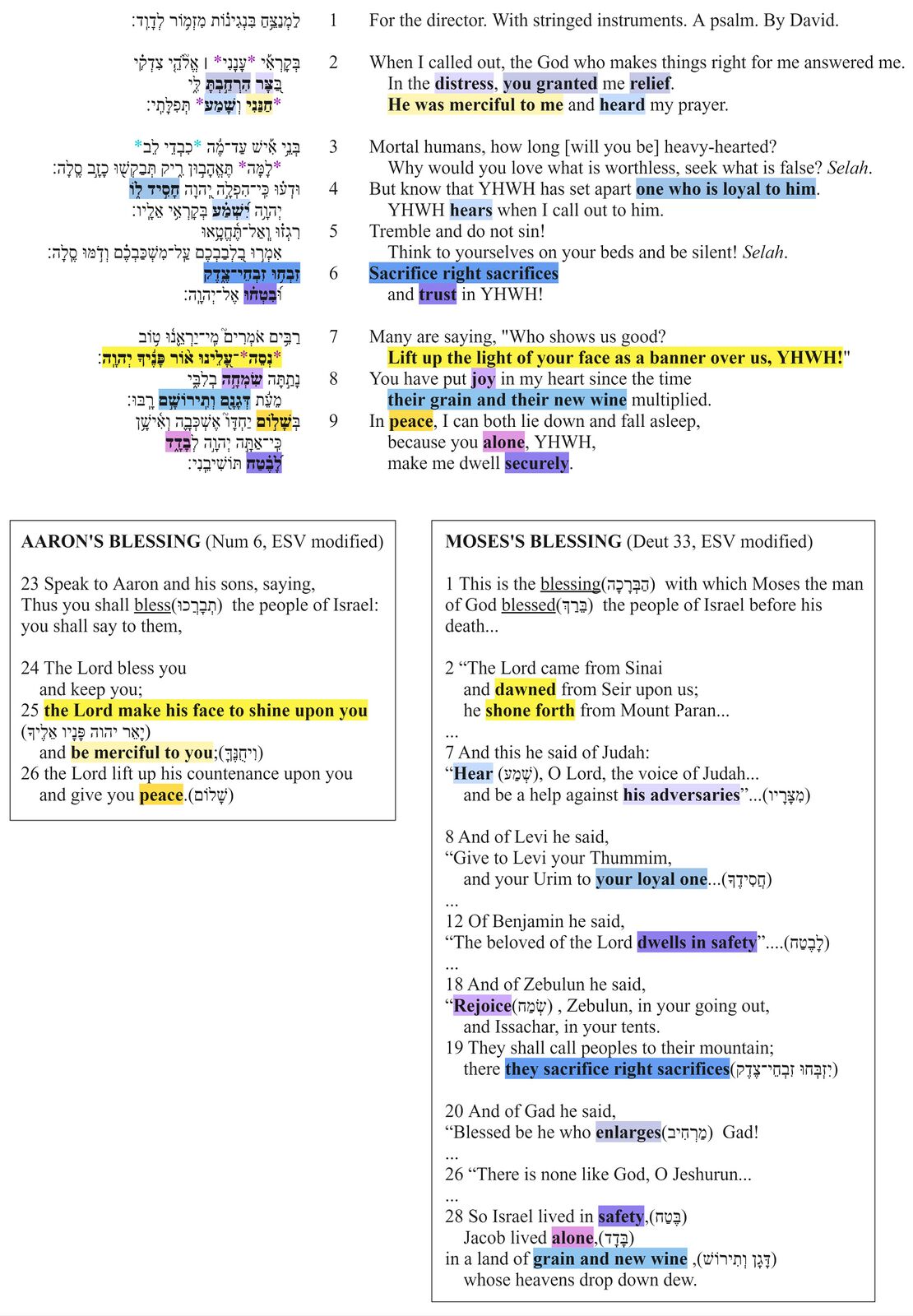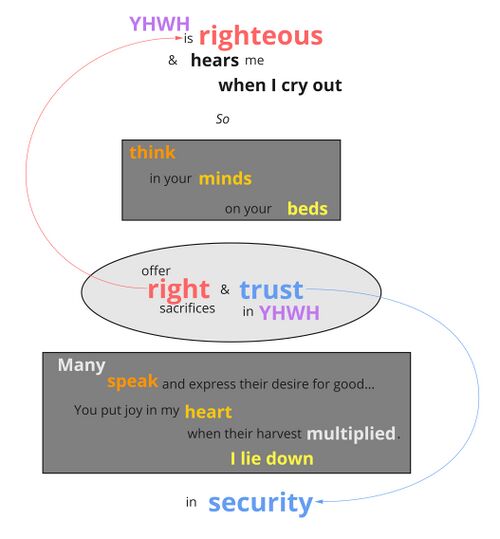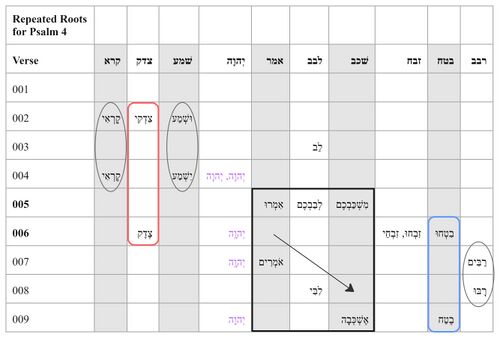Psalm 4 Poetry
About the Poetics Layer
Exploring the Psalms as poetry is crucial for understanding and experiencing the psalms and thus for faithfully translating them into another language. This layer is comprised of two main parts: Poetic Structure and Poetic Features.
Poetic Structure
In poetic structure, we analyse the structure of the psalm beginning at the most basic level of the structure: the line (also known as the “colon” or “hemistich”). Then, based on the perception of patterned similarities (and on the assumption that the whole psalm is structured hierarchically), we argue for the grouping of lines into verses, verses into sub-sections, sub-sections into larger sections, etc. Because patterned similarities might be of various kinds (syntactic, semantic, pragmatic, sonic) the analysis of poetic structure draws on all of the previous layers (especially the Discourse layer).
Poetic Macro-structure
If an emendation or revocalization is preferred, that emendation or revocalization will be marked in the Hebrew text of all the visuals.
| Emendations/Revocalizations legend | |
|---|---|
| *Emended text* | Emended text, text in which the consonants differ from the consonants of the Masoretic text, is indicated by blue asterisks on either side of the emendation. |
| *Revocalized text* | Revocalized text, text in which only the vowels differ from the vowels of the Masoretic text, is indicated by purple asterisks on either side of the revocalization. |
| v. 1 For the director. With stringed instruments. A psalm. By David. | Superscription | |||
| v. 2 When I called out, the God who makes things right for me answered me. In the distress, you granted me relief. He was merciful to me and heard my prayer. | Relief | The God who makes things right for me relieved my distress. | joy, relief | |
| v. 3 Mortal humans, how long [will you be] heavy-hearted? Why would you love what is worthless, seek what is false? Selah. | Invitation | Everyone, stop seeking false gods! They will not satisfy. Sacrifice right sacrifices and trust in YHWH! |
impatience expectation | |
| v. 4 But know that YHWH has set apart one who is loyal to him. YHWH hears when I call out to him. | ||||
| v. 5 Tremble and do not sin! Think to yourselves on your beds and be silent! Selah. | ||||
| v. 6 Sacrifice right sacrifices and trust in YHWH! | ||||
| v. 7 Many are saying, "Who shows us good? Lift up the light of your face as a banner over us, YHWH!" | Blessing | Many are celebrating your blessing and saying, “Lift up the light of your face as a banner over us, YHWH!” You bless those who trust in you with joy, peace, and security. |
peace, confidence | |
| v. 8 You have put joy in my heart since the time their grain and their new wine multiplied. | ||||
| v. 9 In peace, I can both lie down and fall asleep, because you alone, YHWH, make me dwell securely. | ||||
Notes
The poetic structure of this psalm is relatively difficult to determine, and many different structures have been proposed.[1] It is almost impossible for any given structure to account for all of the verbal repetitions (see Repeated Roots chart)[2] and other salient discourse features. The structure proposed here is based on the following repetitions and discourse features:
- The shifts in addressee divide the psalm into three parts: v. 2 (address to God), vv. 3-6 (address to "mortal humans"), vv. 7-9 (address to God).[3]
- The last two parts—the two main parts of the psalm (vv. 3-6; vv. 7-9)—each begin with a question (v. 3: "how long...why...?" v. 7: "who...?) and end with the root בטח (vv. 6b, 9c).[4]
- Verse 6 is the central verse in the psalm, insofar as it repeats roots from the first and last lines of the psalm: צדק (vv. 2a, 6b) and בטח (vv. 6b, 9c). "Thus, beginning and end of the whole are tied to the centre."[5] It is also the shortest verse in the psalm.
- On either side of this central verse is a two-verse unit bound by an inclusio.
- Verses 7-8 are clearly demarcated as a unit by the repetition of רַבִּים and רָבּוּ as the first and last word respectively.
- Verses 4-5 are demarcated as a unit by the repetition of similar imperatives: ודעו at the beginning of v. 4 and ודמו at the end of v. 5. These forms differ only by a single letter.
- Selah, together with the inclusio around vv. 4-5, demarcates sub-units within the second part of the psalm, the address the the mortal humans (vv. 3-6).
- The whole psalm is bound by an inclusio. Verses 2 and 9 are the only three-line verses in the psalm, and both begin with a bet preposition. They also feature YHWH as the agent and the psalmist as the patient. Note also the similarities between being in a broad space (v. 2b) and dwelling in security (v. 9bc).
Line Divisions
Line division divides the poem into lines and line groupings. We determine line divisions based on a combination of external evidence (Masoretic accents, pausal forms, manuscripts) and internal evidence (syntax, prosodic word counting and patterned relation to other lines). Moreover, we indicate line-groupings by using additional spacing.
When line divisions are uncertain, we consult some of the many psalms manuscripts which lay out the text in lines. Then, if a division attested in one of these manuscripts/versions influences our decision to divide the text at a certain point, we place a green symbol (G, DSS, or MT) to the left of the line in question.
| Poetic line division legend | |
|---|---|
| Pausal form | Pausal forms are highlighted in yellow. |
| Accent which typically corresponds to line division | Accents which typically correspond to line divisions are indicated by red text. |
| | | Clause boundaries are indicated by a light gray vertical line in between clauses. |
| G | Line divisions that follow Greek manuscripts are indicated by a bold green G. |
| DSS | Line divisions that follow the Dead Sea Scrolls are indicated by a bold green DSS. |
| M | Line divisions that follow Masoretic manuscripts are indicated by a bold green M. |
| Number of prosodic words | The number of prosodic words are indicated in blue text. |
| Prosodic words greater than 5 | The number of prosodic words if greater than 5 is indicated by bold blue text. |
If an emendation or revocalization is preferred, that emendation or revocalization will be marked in the Hebrew text of all the visuals.
| Emendations/Revocalizations legend | |
|---|---|
| *Emended text* | Emended text, text in which the consonants differ from the consonants of the Masoretic text, is indicated by blue asterisks on either side of the emendation. |
| *Revocalized text* | Revocalized text, text in which only the vowels differ from the vowels of the Masoretic text, is indicated by purple asterisks on either side of the revocalization. |
Notes
- The proposed line division agrees with the MT accents as interpreted by de Hoop and Sanders (2022, §6) in every verse except for v. 3, where we have emended the text based on the Septuagint, and v. 5, where there is additional division after מִשְׁכַּבְכֶ֗ם. The proposed line division for v. 3 agrees with the Septuagint. The proposed division agrees with the Septuagint for all other verses except for v. 6 (where the Septuagint has only one line), v. 9 (where the Septuagint combines v. 9bc into one line), and possibly also v. 5 (where Rahlfs' edition reflects a different text than MT [see grammar note]; in this verse, however, our proposed line division agrees with Sinaiticus and Vaticanus, which might represent the earlier Greek division).
- The first verse (v. 2) and the last verse (v. 9) are three-line verses. All of the other verses are two-line verses.
- The two longest lines are the two lines ending with סֶלָה (vv. 3b, 5b).
Poetic Features
In poetic features, we identify and describe the “Top 3 Poetic Features” for each Psalm. Poetic features might include intricate patterns (e.g., chiasms), long range correspondences across the psalm, evocative uses of imagery, sound-plays, allusions to other parts of the Bible, and various other features or combinations of features. For each poetic feature, we describe both the formal aspects of the feature and the poetic effect of the feature. We assume that there is no one-to-one correspondence between a feature’s formal aspects and its effect, and that similar forms might have very different effects depending on their contexts. The effect of a poetic feature is best determined (subjectively) by a thoughtful examination of the feature against the background of the psalm’s overall message and purpose.
Doubles
If an emendation or revocalization is preferred, that emendation or revocalization will be marked in the Hebrew text of all the visuals.
| Emendations/Revocalizations legend | |
|---|---|
| *Emended text* | Emended text, text in which the consonants differ from the consonants of the Masoretic text, is indicated by blue asterisks on either side of the emendation. |
| *Revocalized text* | Revocalized text, text in which only the vowels differ from the vowels of the Masoretic text, is indicated by purple asterisks on either side of the revocalization. |
Feature
Feature Nearly every root in v. 5b is repeated in vv. 7-9 in the same order in which they first appear in v. 5b:
- אמר - v. 7a ("saying") - v. 5b ("think")
- לבב - v. 8a ("heart") - v. 5b ("yourselves")
- שכב - v.9a ("lie down") - v. 5b ("beds")
Verse 6, which repeats none of the roots of v. 5b, repeats roots from the first line of the Psalm (צדק "right") and the last line of the Psalm (בטח "trust/securely").
Every repeated root is used once in relation to YHWH's people and at least once in relation to humanity:
- "many are saying" (אמרים) (v. 7) // "think" (אמרו) (v. 5)
- "my heart" (לבי) (v. 8) // "your hearts " (לבב) (v. 5) "heavy-hearted" (v. 3)
- "I will lie down" (שׁכב) (v. 9) // "your beds" (משׁכב) (v. 5)
- "right for me" (צדק) (v. 2) // "(you) sacrifice right sacrifices" (צדק) (v. 6)
- "you make me dwell securely" (בטח) (v. 9) // "(you) trust in YHWH" (בטח) (v. 6)
Effect
David and Israel, whom he represents as king, show the world what it looks like to experience true blessing. YHWH has set David and Israel apart for special treatment (v. 4), and his blessing on them is like a "banner" to which others are called to rally (v. 7b).
In contrast, others put their hope in false and worthless gods (v. 3). In response, David addresses this mass of idol-worshipping humanity and says, in effect, "Look at how YHWH has blessed us! Come be like us! The security (בטח), rightly ordered well-being (צדק), joy-filled hearts (לב), and peaceful sleep (שׁכב) that our God gives to us can be yours as well, if you will imitate us and trust in him!"
A Bright Distinction
If an emendation or revocalization is preferred, that emendation or revocalization will be marked in the Hebrew text of all the visuals.
| Emendations/Revocalizations legend | |
|---|---|
| *Emended text* | Emended text, text in which the consonants differ from the consonants of the Masoretic text, is indicated by blue asterisks on either side of the emendation. |
| *Revocalized text* | Revocalized text, text in which only the vowels differ from the vowels of the Masoretic text, is indicated by purple asterisks on either side of the revocalization. |
Feature
The collocation "heavy" (כבד)–"heart" (לב), glossed here as "stubborn" (v. 3), is always elsewhere associated with the Exodus event and with the plagues in particular (Exod 7:14; 8:11, 28; 9:7, 34; 10:1; 1 Sam 6:6). The Pharaoh of the Exodus is the prototypical example of what it means to be "heavy of heart:" "Pharaoh’s heart is stubborn (כָּבֵד לֵב פַּרְעֹה), and he still refuses to let the people go" (Exod 7:14, NLT).
Similarly, the word "set apart" in v. 4 (הִפְלָה) only occurs elsewhere in the account of the Exodus plagues (Exod 8:18; 9:4; 11:7), where it refers to YHWH's special treatment of the Israelites: "But on that day I will deal differently with (וְהִפְלֵיתִי) the land of Goshen, where my people live; no swarms of flies will be there, so that you will know that I, the Lord, am in this land. I will make a distinction between my people and your people" (Exod 8:18-19 [Eng: 22-23], NIV).
The "light" imagery in v. 7 and hinted at elsewhere in the psalm—the first word of the psalm, בְּקָרְאִי, sounds like the word for "morning," בֹּקֶר—also relates to the Exodus plagues. In the ninth plague (Exod 10:21ff), "total darkness covered all Egypt for three days... Yet all the Israelites had light in the places where they lived" (Exod 10:22–23).
Effect
The psalm alludes to the Exodus story and to the account of the plagues in particular. This story serves as an excellent illustration of the psalm's message: YHWH has uniquely blessed his people. The Pharaoh-like nations, who harden their hearts and seek after false gods (v. 3), refusing to acknowledge YHWH's supremacy, should recognize how YHWH has set apart Israel for special treatment (v. 4). While the rest of the world is living in darkness (cf. v. 5 "on your beds... be silent"), the "light" of YHWH's face (i.e., YHWH's favor and blessing) is raised over Israel like a banner, marking them out as unique and as a place to which others can rally (see the "banner" imagery chart).
Blessings Fulfilled
If an emendation or revocalization is preferred, that emendation or revocalization will be marked in the Hebrew text of all the visuals.
| Emendations/Revocalizations legend | |
|---|---|
| *Emended text* | Emended text, text in which the consonants differ from the consonants of the Masoretic text, is indicated by blue asterisks on either side of the emendation. |
| *Revocalized text* | Revocalized text, text in which only the vowels differ from the vowels of the Masoretic text, is indicated by purple asterisks on either side of the revocalization. |
Feature
Psalm 4 has several clear linguistic connections to two passages in the Torah: the Aaronic blessing in Num 6 and the Mosaic blessing in Deut 33 (see the visual). Nearly every verse of Ps 4 has at least one clear linguistic connection to one of these blessings (vv. 2, 4, 6, 7, 8, 9), and the majority of verses have multiple points of connection (vv. 2, 6, 7, 8, 9). Although the word "blessing" is never used in Ps 4, it is notable that Ps 4 follows Ps 3, and the last clause of Ps 3 says, "your blessing is on your people."
Effect
By alluding to these blessings in the Torah, Ps 4 presents itself as a celebration of YHWH's blessing on his people. From the perspective of Ps 4, the people have recently experienced YHWH's blessing in an abundant harvest (see v. 8), and now, drawing from the language of these two great blessings (Aaronic and Mosaic), they celebrate YHWH's provision and reflect on how these historic blessings are being fulfilled in their present experience.
Even the psalm's exhortation to the "mortal humans" to turn from idols and sacrifice right sacrifices to YHWH (vv. 3–6) is based in the Mosaic blessing, which says, "They will invite peoples to their mountain; there they will sacrifice right sacrifices" (Deut 33:19).
Repeated Roots
The repeated roots table is intended to identify the roots which are repeated in the psalm.
| Repeated Roots legend | |
|---|---|
| Divine name | The divine name is indicated by bold purple text. |
| Roots bounding a section | Roots bounding a section, appearing in the first and last verse of a section, are indicated by bold red text. |
| Roots occurring primarily in the first section are indicated in a yellow box. | |
| Roots occurring primarily in the third section are indicated in a blue box. | |
| Roots connected across sections are indicated by a vertical gray line connecting the roots. | |
| Section boundaries are indicated by a horizontal black line across the chart. | |
Notes
- Root repetition is especially prominent in this psalm.[6]
- Every verse has a repeated root in it
- Verses 5-6 have the highest concentration of repeated roots
- Almost every word of v. 5b is repeated in the following verses (vv. 7-8) in the order in which they appeared in v. 5b (marked with black box and arrow):
- The root אמר (v. 5b--> v. 7)
- The root לב (v. 5b--> v. 8)
- The root שׁכב (v. 5b--> v. 9)
- These repetitions reinforce the thematic significance of v. 5b, which is also the central, and longest, line of the psalm.
- Verse 6 repeats roots from the first (צדק; boxed in red) and last (בטח; boxed in blue) lines of the psalm, making it central to the psalm's structure.[7]
- The repetitions of קרא + שׁמע (vv. 2-4) and רבב (vv. 7-8; all circled in black) have poetic structure significance (see poetic structure).
Bibliography
- Baethgen, Friedrich. 1904. Die Psalmen. Göttingen: Vandenhoeck und Ruprecht.
- Barré, Michael L. 1995. “Hearts, Beds, and Repentance in Psalm 4,5 and Hosea 7,14.” Biblica 76 (1): 53–62.
- Barthélemy, Dominique. 2005. Critique Textuelle de l’Ancien Testament. Vol. Tome 4: Psaumes. Fribourg, Switzerland: Academic Press.
- Bons, Eberhard. 2011. “Psalmoi / Das Buch Der Psalmen.” In Septuaginta Deutsch: Erläuterungen und Kommentare zum griechischen Alten Testament, edited by Martin Karrer and Wolfgang Kraus. Vol. 2. Stuttgart: Deutsche Bibelgesellschaft.
- Briggs, Charles A., and Emilie Briggs. 1906. A Critical and Exegetical Commentary on the Book of Psalms. Vol. 1. ICC. Edinburgh: T & T Clark.
- Brown, William P. 2002. Seeing the Psalms: A Theology of Metaphor. Louisville, KY: Westminster John Knox Press.
- Buttenwieser, Moses. 1938. The Psalms: Chronologically Treated with a New Translation. University of Chicago Press.
- Craigie, Peter C. 1983. Psalms 1–50. WBC 19. Waco, TX: Word.
- Cook, John A. 2024. The Biblical Hebrew Verb: A Linguistic Introduction. Learning Biblical Hebrew. Grand Rapids: Baker Academic.
- Dahood, Mitchell. 1963. “Hebrew-Ugaritic Lexicography I.” Biblica 44 (3): 289–303.
- Dahood, Mitchell. 1966. Psalms. Vol. 1. Anchor Bible Commentary. New York: Doubleday.
- Driver, G. R. 1942. “Notes on the Psalms. I. 1—72.” The Journal of Theological Studies 43 (171/172): 149–60.
- Duhm, Bernhard. 1899. Die Psalmen. Mohr Siebeck.
- Eaton, John. 1975. Kingship and the Psalms. Studies in Biblical Theology, 2d ser., 32. London: S.C.M. Press.
- Fokkelman, J. P. 2000. Major Poems of the Hebrew Bible: At the Interface of Hermeneutics and Structural Analysis. Studia Semitica Neerlandica. Assen, The Netherlands: Van Gorcum.
- Garrett, Duane A. 1997. Hosea, Joel. The New American Commentary 19A. Nashville: Broadman & Holman.
- Geller, Stephen. 2018. “The ‘Precative Perfect’ in Psalms and the Struggle for Faith.” In The Unfolding of Your Words Gives Light: Studies on Biblical Hebrew in Honor of George L. Klein, edited by Ethan C. Jones. University Park, Pennsylvania: Eisenbrauns.
- Gentry, Peter J. 1998. “The System of the Finite Verb in Classical Hebrew.” Hebrew Studies 39:7–39.
- Gesenius, W. Donner, H. Rüterswörden, U. Renz, J. Meyer, R. (eds.). 2013. Hebräisches und aramäisches Handwörterbuch über das Alte Testament. Berlin: Springer.
- Goldingay, John. 2006. “Psalm 4: Ambiguity and Resolution.” Tyndale Bulletin 57 (2): 161–72.
- Grosser, Emmylou. 2023. Unparalleled Poetry: A Cognitive Approach to the Free-Rhythm Verse of the Hebrew Bible. Cognition and Poetics. New York: Oxford University Press.
- Gunkel, Hermann. 1926. Die Psalmen. 4th ed. Göttinger Handkommentar zum Alten Testament 2. Göttingen: Vandenhoeck & Ruprecht.
- Hossfeld, Frank-Lothar, and Erich Zenger. 1993. Die Psalmen I: Psalm 1–50. Neue Echter Bibel. Würzburg: Echter.
- Ibn Ezra. Ibn Ezra on Psalms.
- Jacobson, Rolf A., et al. 2014. The Book of Psalms. NICOT. Grand Rapids, MI: Eerdmans.
- John Chrysostom. 1998. St. John Chrysostom Commentary on the Psalms. Translated by Robert C. Hill. Brookline, MA: Holy Cross Orthodox Press.
- Kennicott, Benjamin. 1776. Vetus testamentum hebraicum : cum variis lectionibus.
- Kim, Young Bok. 2023. Hebrew Forms of Address: A Sociolinguistic Analysis. Atlanta: SBL Press.
- Kselman, John. 1987. “A Note on Psalm 4:5.” Biblica 68 (1): 103–5.
- Lagarde, Paul de. 1886. “Novae Psalterii Graeci editionis specimen.” In Abhandlungen der Königlichen Gesellschaft der Wissenschaften zu Göttingen. Göttingen: In der Dieterischen Buchhandlung.
- Malbim. Malbim on Psalms.
- Mannati, M. 1970. “Sur Le Sens de Min En Ps IV 8.” Vetus Testamentum 20 (3): 361–66.
- Moshe Yitzhak Ashkenazi. Ho'il Moshe.
- Olmo Lete, Gregorio del, and Joaquín Sanmartín. 2004. A Dictionary of the Ugaritic Language in the Alphabetic Tradition. Leiden ; Boston: Brill.
- Pietersma, Albert. 2021. “Psalm 4 A Commentary on the Text–as–Produced.”
- Pritchard, James Bennett. 1969. Ancient Near Eastern Texts Relating to the Old Testament with Supplement. Third edition. Princeton: Princeton University Press.
- Radak. Radak on Psalms.
- Rashi. Rashi on Psalms.
- Reyburn, William David. 1992. A Handbook on Lamentations. UBS Helps for Translators. New York: United Bible Societies.
- Robar, Elizabeth. 2020. “Ethan C. Jones (Ed.), The Unfolding of Your Words Gives Light: Studies on Biblical Hebrew in Honor of George L. Klein.” Journal of Semitic Studies 65 (2): 633–39.
- Ryken, Leland, et al., eds. 1998. Dictionary of Biblical Imagery. Downers Grove, Ill: InterVarsity Press.
- Spieckermann, Hermann. 2023. Psalmen. 1: Psalm 1 - 49. Das Alte Testament Deutsch, 14,1. Göttingen: Vandenhoeck & Ruprecht.
- Staszak, Martin. 2024. The Preposition Min. Beiträge zur Wissenschaft vom Alten und Neuen Testament (BWANT) 246. Stuttgart: Kohlhammer.
- Taylor, Richard A. 2020. The Psalms According to the Syriac Peshitta Version with English Translation. Piscataway: Gorgias Press.
- Waltke, Bruce K., J. M. Houston, and Erika Moore. 2010. The Psalms as Christian Worship: A Historical Commentary. Grand Rapids, MI: William B. Eerdmans Pub. Co.
- Weber, Beat. 2016. Werkbuch Psalmen. 1: Die Psalmen 1 bis 72, zweite, aktualisierte Auflage. Stuttgart: Verlag W. Kohlhammer.
- Weiser, Artur. 1962. The Psalms: A Commentary. Philadelphia: Westminster Press.
- Wilson, Gerald H. 2002. Psalms. Vol. 1. NIVAC. Grand Rapids: Zondervan.
- Zenger, Erich. 1990. “‘Gib mir Antwort, Gott meiner Gerechtigkeit’ (Ps 4,2): Zur Theologie des 4. Psalms.” In Die Alttestamentliche Botschaft als Wegweisung, edited by Josef Zmijewski, 377–403. FS H. Reinelt: Stuttgart.


